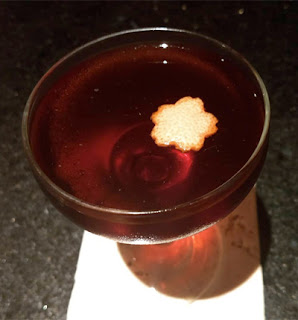1/2 oz Lime Juice (3/4 oz)
1 tsp Green Crème de Menthe (1/4 oz Tempus Fugit White + 1 drop green food coloring)
1 tsp Simple Syrup (1/4 oz)
1 tsp Orange Curacao (3/8 oz Cointreau)
1/2 tsp Triple Sec (combined with above)
1 oz Light Rum (1 1/2 oz Privateer Tres Aromatique Overproof White Rum)
Shake with ice, strain into a Sour glass (snifter), fill with ice, and garnish with a lime wedge speared to a green cocktail cherry (mint sprigs).
Sunday night after my bar shift, I decided to make a recipe that I had read about that morning as I made my way cover to cover through Beachbum Berry's
Remixed called the Fu Manchu. The drink was created by Sax Rohmer who featured the character Fu Manchu as a villain in his books, and he wanted a green drink to capture the energy. While Rohmer crafted many version, Berry found that this 1947 one was the best. While the recipe calls for a Sour glass, it was often served in a Fu Manchu mug that has come under a lot of heat for its cultural appropriation. An Al Sotack
article in Vice's Muchies series best explained the dilemma by quoting Paul McGee, "We're sensitive to the origins of tiki, and how it was a concept developed 80 years ago during a time when 'cultural appropriation' was not a mainstream concern in America. Some of the early tiki bars presented artifacts of Polynesian cultures outside of their sacred context and meaning, and without respect to the significance those items held in Polynesian culture. We do have some mugs with 'tiki' illustrations, but there are other mugs on the market that we don't feel comfortable using in service. For example, the Fu Manchu mug, and any hula girl or 'native babe' mugs."

I probably avoided the drink due to this concern coupled with not having green crème de menthe, but I decided that the recipe was worth trying and green food coloring could solve the second issue. In the glass, the Fu Manchu delivered an orange-herbal mint bouquet that was supplemented by my choice of mint garnish. Next, lime and orange paired elegantly on the sip, and the swallow began with funky rum flavors and ended with minty herbal elements. Given how restrained and elegant Tempus Fugit's liqueur is to cheaper ones, perhaps doubling the amount and removing the simple syrup ingredient would help shift this in the right direction.













 2 oz London Dry Gin (Beefeater)
2 oz London Dry Gin (Beefeater)

















 The 2017 collection of 855 drink recipes, bartender tributes, and essays on hospitality from CocktailVirgin's Frederic Yarm. Available at Barnes and Noble and Amazon.
The 2017 collection of 855 drink recipes, bartender tributes, and essays on hospitality from CocktailVirgin's Frederic Yarm. Available at Barnes and Noble and Amazon. The 2012 collection of 505 drink recipes, techniques, and Boston bar recommendations from Frederic Yarm. Available at Amazon and Barnes and Noble.
The 2012 collection of 505 drink recipes, techniques, and Boston bar recommendations from Frederic Yarm. Available at Amazon and Barnes and Noble.